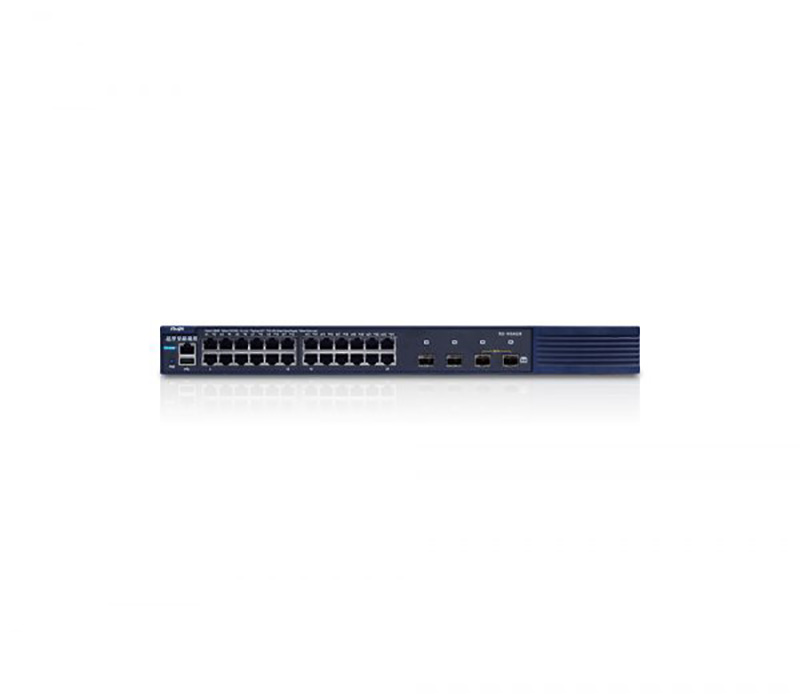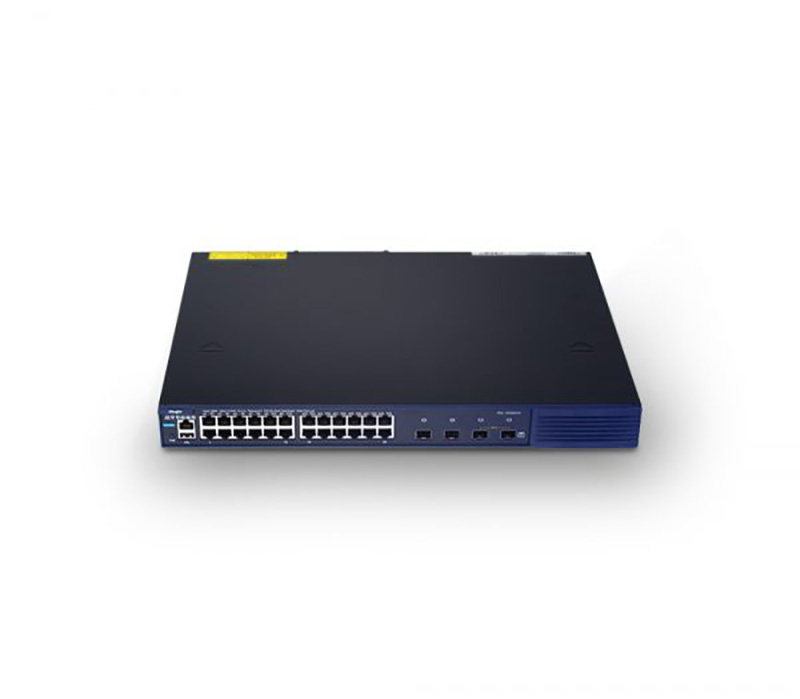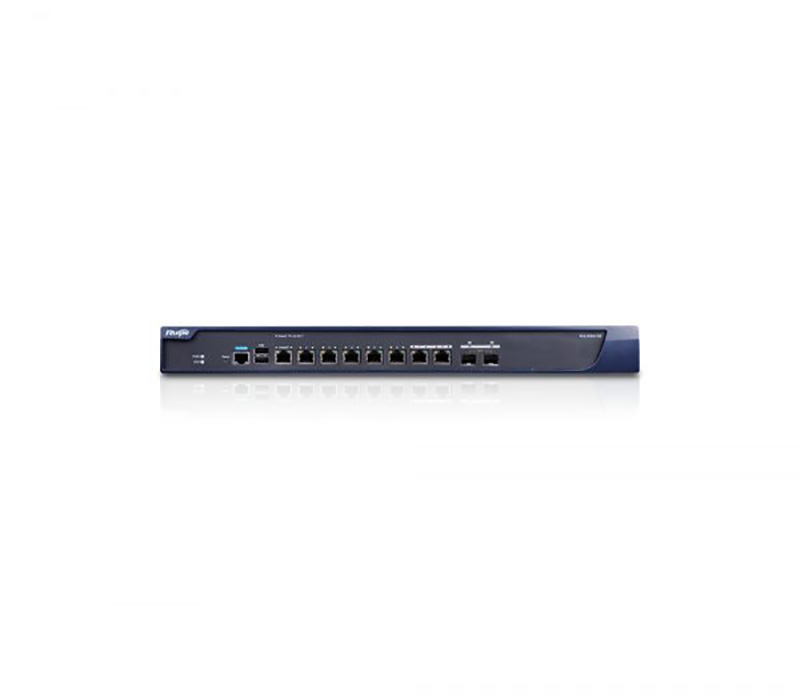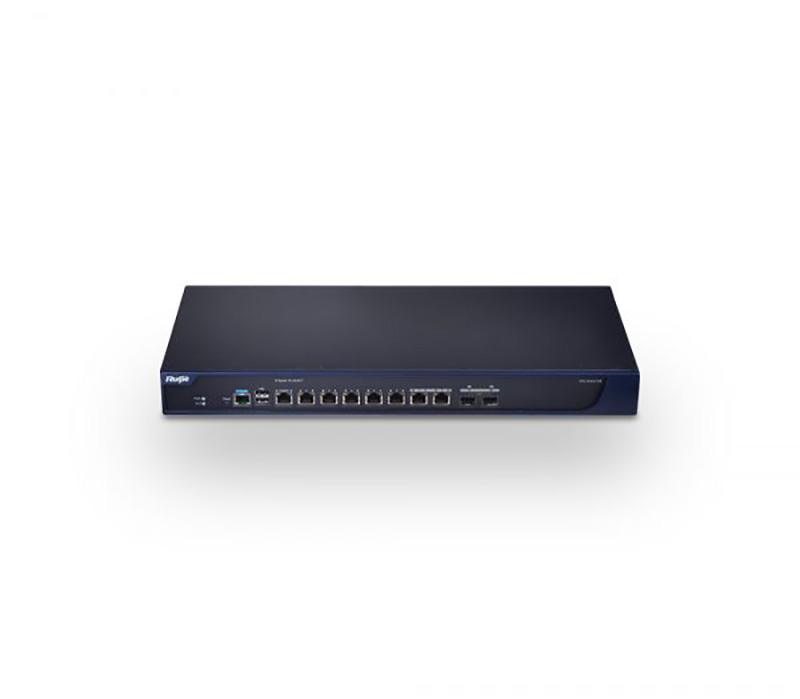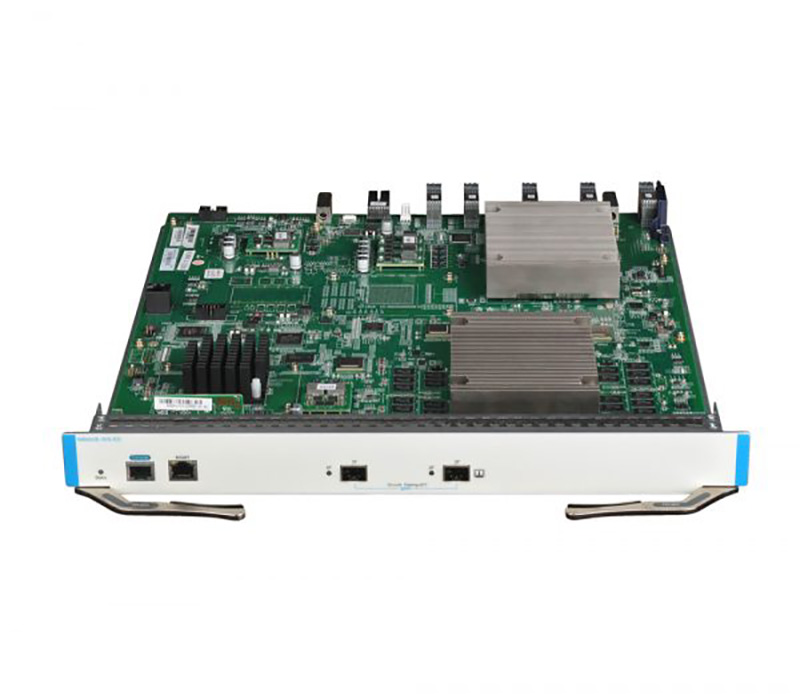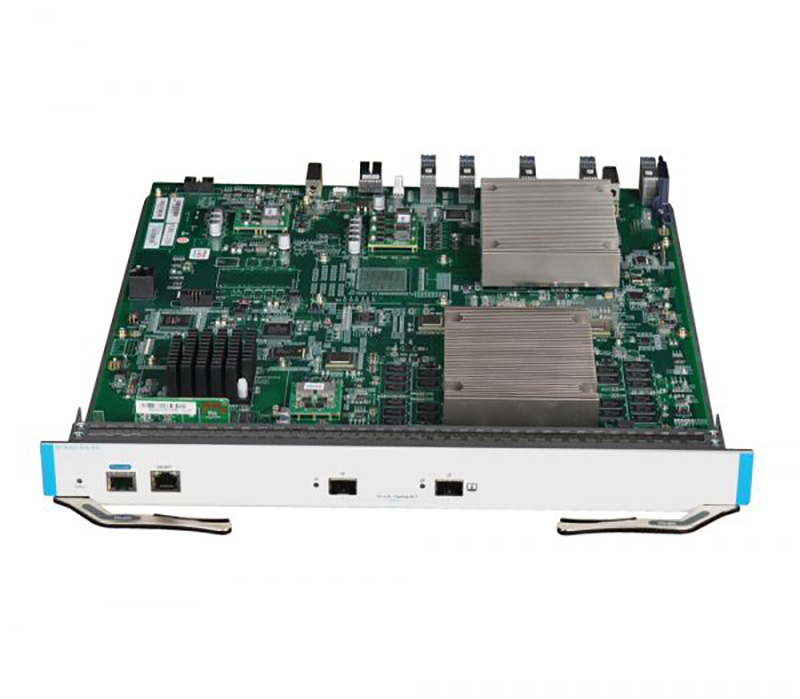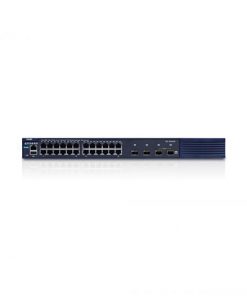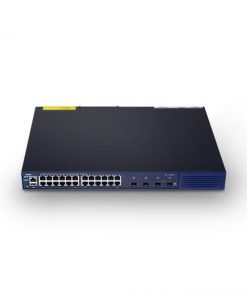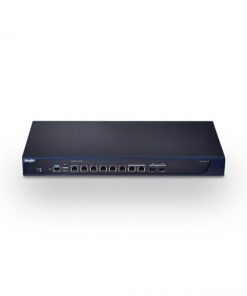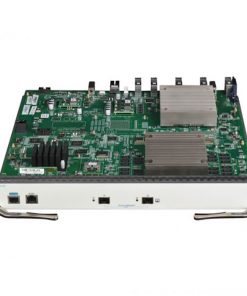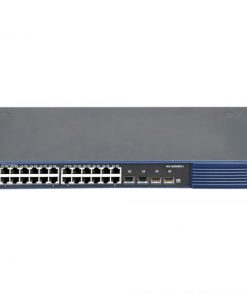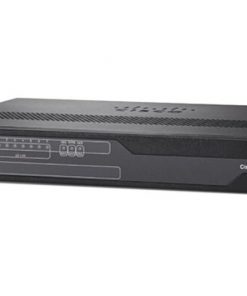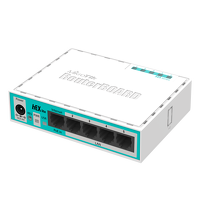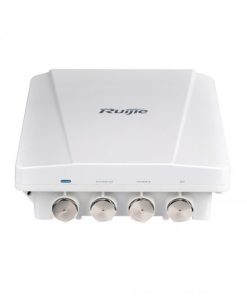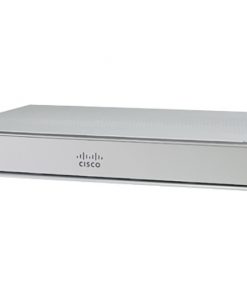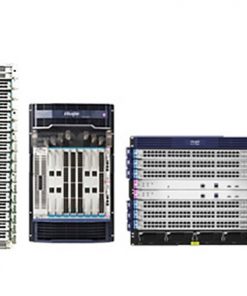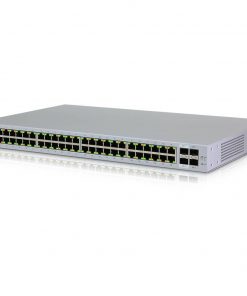Ruijie Wireless Controller Series is designed to support the next-generation high-speed wireless network. Ruijie Wireless Controllers can be deployed at either Layer 2 or Layer 3 network to communicate with Ruijie Wireless access point (AP) without any architecture or hardware changes, offering seamless and secure wireless control. Ruijie Wireless Controllers can manage up to 128 APs by default and a maximum capacity of 2,560 APs with license upgrade.
Ruijie Wireless Controllers support centralized and transparent network management, Ruijie Wireless greatly simplifying network deployment. With Ruijie’s leading RG-SNC Smart Network Commander and AP series, Ruijie Wireless Controllers significantly minimize deployment workload by supporting Ruijie Wireless AP configuration management, radio frequency (RF) coverage optimization and cluster management.
Ruijie Wireless Controllers enable role-based network services with cutting-edge security and clustering technologies. Ruijie clustering technology shares Ruijie Wireless user database among multiple controllers and allows Wi-Fi users to roam seamlessly within the network. The Ruijie Wireless Controllers truly deliver smooth wireless voice communications and other services with superior security and availability.
Feature highlgihts of Ruijie Wireless Controller Series:
● Scalable up to 2,560 APs and 80K Clients
● Built-in with Advanced Wireless Radio Management and WIPS Security Protection
● Support Seamless L2/L3 Roaming
● Support N+a, N+N Resiliency
● Built-in with Portal Server for Web Authentication
Smart Ruijie Wireless Experience
Intelligent Identification of Smart Devices
The built-in portal server of the Ruijie Wireless Controller Series intelligently identifies the type of smart device, delivering an adaptive authentication page that fits the screen automatically. The intelligent feature eliminates the trouble of screen size adjustment and hence offers a better wireless user experience. Ruijie Wireless supports all mainstream operating systems including Apple iOS, Android, and Windows.
Fair Scheduling
Ruijie Wireless teaming up Ruijie’s leading AP series, the Ruijie Wireless Controller Series supports equal access time for smart devices no matter they are running 802.11g, 802.11n, 802.11ac or other standards. The feature eliminates high latency, slow network speed and poor AP performance problems. Such problems are due to using an old wireless LAN card or long distance between the end devices and AP. The Wireless Controller Series ensures a fair high-speed wireless network for all devices anywhere and anytime.
Fair Scheduling Mechanism
Intelligent Load Balancing
On a high-density wireless LAN, the Ruijie Wireless Controller Series intelligently distributes users among different APs according to the number of users and data traffic in real time. This feature balances the load pressure on each AP and improves the average bandwidth and Quality of Service (QoS), offering higher network availability. In addition to the role-based and traffic-based balancing features, the Ruijie Wireless Controller Series also supports load balancing in terms of frequency range. Since the majority of Wi-Fi devices work at 2.4GHz by default while the frequency above 5GHz (802.11a/n/ac) can offer better throughput performance. With the frequency-based load balancing, the Wireless Controller Series allows users with dual-band devices to connect to the 5GHz as first priority. Bandwidth usage is greatly increased by 30-40% with no additional cost. The Wireless Controller Series hence delivers the best-in-class wireless experience to all Ruijie clients.
Intelligent Load Balancing Mechanism
High Performance and Reliability
Exclusive 24-port PoE Support
In the Wireless Controller Series, the RG-WS6024 model tops the class by offering PoE power support and all-in-one wired and wireless management. The versatile controller supports wired Gigabit Ethernet access, 10G fiber uplink, and PoE/PoE+ power supply. The RG-WS6024 offers three PoE power supply modes – auto, energy-saving and static – to meet various deployment challenges. When an interface is down for a certain period of time, the system will automatically power it down for extra energy efficiency. EEE energy-saving mode is another feature highlight. The system will automatically turn an idle port into energy-saving mode. When there is a new packet, the system will issue listening streams to the port to resume service. In addition, the controller offers management of up to 24 APs and is scalable to up to 128 APs with license upgrade. The RG-WS6024 is ideal acting as the wireless core for general education, small and medium business networks, and enterprise branches.
Outstanding Scalability and Power Redundancy
The RG-WS6816 model is another featured model. The controller supports up to 2 expansion modules, offering 4 1000BASE-T/1000BASE-X combo ports (WNM-4GE-S) and 2 10GBASE-X ports (WNM-2XS-S). The RG-WS6816 also supports up to 2 power modules for extra resiliency.
Centralized or Distributed Intelligent Switching
The Wireless Controller Series can be deployed at Layer 2 or Layer 3 level without modifying the original network architecture. Forming an integrated switching framework with the APs, the controllers handle all the AP data exchange management with ease.
With the industry-leading local forwarding technology, the Wireless Controller Series eliminates traffic bottlenecks that alternatives in the market have been struggling with. The local forwarding technology allows flexible deployment of AP data forwarding. In other words, the AP can determine whether to forward all data via the controller based on Service Set ID (SSID) and user VLAN, or to send the data directly to a wired network for local data exchange. The local forwarding technology enables large-scale, delay-sensitive, and real-time data transmission via the wired network. With the high throughput of 802.11ac, it greatly alleviates the traffic pressure on the controller. The feature also makes the wireless controllers more adaptive to heavy traffic demand applications such as high definition Video on Demand (VoD) and Voice over Wireless LAN (VoWLAN) in the future.
Flexible VLAN / IP-based Local Forwarding Policy
Intelligent RF Management
The Wireless Controller Series enables an AP to perform on-demand RF scanning in the wireless environment. By scanning the wireless frequency bands and channels, both rogue APs and networks can be identified easily. The AP will alert network administrators for immediate action once such are found, providing round-the-clock network protection. In addition, the Wireless Controller Series can control the real-time RF scanning function for signal and interference measurement. The controller software also dynamically adjusts traffic load, power, RF coverage, and channel allocation for maximized signal coverage and capacity.
Dead Zone Auto-coverage and Channel Adjustment
Seamless Roaming Experience
The advanced clustering technology enables real-time synchronization of online information and roaming records of all users among multiple Wireless Controllers. Simply put, user and authentication data are shared in the cluster, enabling wireless users to roam freely in the whole network. Users can enjoy a borderless and secure roaming experience with the IP address and authentication status remained unchanged. The Wireless Controller Series supports fast roaming and voice services with the clustering technology.
Seamless L2 & L3 Roaming
Remote Intelligent Perception Technology (RIPT)
In the traditional network architecture where FIT APs are centrally managed by a wireless controller, packets received by the AP must be transmitted to the controller before being forwarded. When the wireless controller becomes faulty, the APs will fail to work properly causing whole network breakdown. Ruijie’s latest RIPT provides you a complete disaster recovery solution and enables the Wireless Controller Series to implement intelligent link perception. Once the faulty controller is detected, the APs will quickly switch to the intelligent mode to continue data forwarding, ensuring the high availability of the wireless network and keeping wireless users always online.
Remote Intelligent Perception Technology (RIPT) – Disaster Recovery
Abundant QoS Policies
The Wireless Controller Series supports an extensive array of QoS policies. By setting bandwidth limitations, higher priority is given to critical applications over the others. The Wireless Controller Series hence delivers guaranteed bandwidth performance for network of all sizes.
Wireless IPv6 Access
The Wireless Controller Series fully supports IPv6 features and implements IPv6 forwarding in a wireless network. Both IPv4 and IPv6 users can automatically connect to the controller over tunnels, enabling IPv6 applications to be borne on the wireless network.
Flexible and Comprehensive Security Policies
Local Authentication
The Wireless Controller Series supports a local user database. Together with the built-in portal, the controllers support web authentication for wireless users with ease. Local authentication based on the actual user demand is achieved for maximized cost savings, getting rid of extra devices such as external portal and RADIUS server. The network infrastructure is also greatly simplified. The Wireless Controller Series guarantees high security for small and medium-sized networks at a possibly lowest price.
User Data Encryption
The Wireless Controller Series fully supports the advanced encryption technologies such as Wired Equivalent Privacy (WEP), Temporal Key Integrity Protocol (TKIP), and Advanced Encryption Standard (AES), ensuring end-to-end security of data transmission over the wireless network.
Standard Communication Protocol
Encrypted communication between the controller and APs is enabled with the international standard Control and Provisioning of Wireless Access Points (CAPWAP). The function ensures complete isolation from the wired network and guarantees high security for the real-time communication between the Wireless Controller and APs. CAPWAP also allows deployment of third-party APs in the future, offering superior scalability, availability and maximized user investment at the same time.
Virtual Wireless Packet Technology
With the virtual AP technology, the Wireless Controller Series can partition multiple SSIDs within the network. Network administrator can separately encrypt and isolate subnets or VLANs that have the same SSID. The deployment thereby enables specified authentication mode and encryption mechanism for each SSID.
RF Security
The Wireless Controller Series enables AP to support RF probe scanning. The feature efficiently detects unauthorized access points or other RF interference sources. Administrator will get alerts once such are detected, providing an easy way to monitor potential threats and usage status.
Protection Against Viruses and Attacks
The Wireless Controller Series provides a wide range of built-in security mechanisms against virus spread and network traffic attacks. The mechanisms ensure secure network access by the authorized users only. Such protection mechanisms include IP/MAC/WLAN binding, hardware ACL control, traffic-based bandwidth limitation and more. The Wireless Controller Series is an ideal match for large campus, hospital, or enterprise networks with high security demand for guest network access.
Secure User Access
The Wireless Controller Series supports Web Authentication, allowing users to perform authentication using any web browser.
802.1X authentication is another security highlight. A major difference from web authentication is that 802.1X enables IP/MAC/WLAN binding after authentication. The feature totally guarantees the legitimacy of the user’s identity.
The Wireless Controller Series also supports Ruijie RG-SMP Security Management Platform to provide insight into and control of Ruijie security and network devices. The RG-SMP offers comprehensive security management across a wide range of Ruijie security appliances and allows users to manage office networks of all sizes for a wide range of industries, with security compliance requirements in aspects of user identity, host health and security of network communication.
Flexible Authentication Modes
In addition to the traditional Web Authentication and 802.1X Authentication, the Wireless Controller Series also supports PEAP Authentication, SMS Authentication, and QR Code Authentication.
The PEAP Authentication allows users to perform password authentication for once only. That means users are only required to enter credentials during their first network visit.
If the SMS authentication is adopted, users first sign in with their mobile phone numbers and then receive an SMS with login username and password for network access.
QR code authentication is another wireless security highlight. After accessing a wireless network, users will obtain a QR code on their end devices and simply ask any authorized staff’s to scan it for network access.
Advanced Guest Wireless Interfaces of the QR Code Authentication
Protection Against ARP Spoofing
Address Resolution Protocol (ARP) detection effectively protects network users from ARP gateway spoofing and host spoofing for secure wireless access. Automatic binding can be enabled in both dynamic and static IP address allocation environments to greatly save manpower resources and management costs. The Wireless Controller Series can monitor and control the rate of ARP packets transmitted to prevent malicious use of scanning tools, which triggers ARP flooding and causes network congestion.
Rogue AP Countermeasure
The Wireless Controller Series enables effective rogue AP detection and containment to enhance wireless security. The controllers arrange an active AP to perform rogue detection, send probe packets and hear probe responses from other valid APs. Network administrator can hence easily single out rogue APs to ensure wireless network security.
Rogue AP and User Countermeasures
DHCP Security
With Dynamic Host Configuration Protocol (DHCP) snooping, the Wireless Controller Series permits DHCP response messages from the trusted ports only. The controllers can thus prevent unauthorized deployment of any DHCP server to disturb the allocation and management of IP addresses and affect normal operation of the network. With the DHCP monitoring function, the Wireless Controller can effectively prevent ARP host spoofing and source IP address spoofing in the dynamic IP allocation environment by dynamically monitoring ARP and checking source IP address.
Management Information Security
To ensure the security of devices and offer protection against attacks, the Secure Shell (SSH) and SNMPv3 technologies encrypt management information by Telnet and Simple Network Management Protocol (SNMP). The Wireless Controller Series offers Telnet access control based on source IP address, offering a high level of granularity on device management. Only the IP addresses authorized by network administrator can log into the controller, which further enhances the security of device network management.
Unified Network Management
Multiple Management Protocols and Unified Management Platform
The Wireless Controller Series supports a vast number of management modes including Command Line. The controllers offer centralized and efficient planning, deployment, monitoring, and management of all APs with minimized investment costs. Working with the Ruijie RG-SNC Smart Network Commander which is an all-rounded network management platform, the Wireless Controller Series delivers enriched network management services such as topology generation, AP operation status, online user status, entire network RF planning, user location, security alert, link load, device utilization rate, roaming record and report output. These functions enable network administrator to monitor and manage the operation status of the entire network in the data center.
Ruijie SNC Unified Topology Diagram
Web Interface Management
The Wireless Controller Series supports a web management interface, which provides simplified wireless configuration and high visibility for the whole network operation. With the AC web interface, the controllers do not only manage the APs, but also the associated AP users. The feature achieves control on user bandwidth control and network access. Network administrator can hence plan, operate and maintain the wireless network with ease.
Ruijie Smart Web Management Interface
Next-Gen Cloud Infrastructure & Technologies
Centralized User Management
In the Wireless Controller Series, RG-M8600E-WS-ED and RG-M18000-WS-ED (for Ruijie RG-S8600E and RG-N18000 switch series respectively) take up a core role for centralized user management in Ruijie’s ingenious Simplicity Campus Network (SCN) Solution. Teaming up with the respective switch series and built-in/external 802.1X/Portal authentication systems, both wireless controller modules support unified wired and wireless authentication on the core device. The modules support an ultra-large ARP capacity, concurrent ≥90K IPv4/IPv6 dual stack devices for centralized authentication at up to 1,000 devices per second.
RG-M18000-WS-ED and RG-M8600E-WS-ED are exclusively designed for switches above
Multi-processing Modular Operating System
Ruijie has been devoting R&D resources on modular operating system since 1998. The software platform of RG-M8600E-WS-ED and RG-M18000-WS-ED is designed based on the next-gen RGOS 11.X multi-processing modular operating system. The OS integrates service features such as firewall, wireless, IPFIX and authentication all into one cloud platform. The platform hence fully supports virtualization and offers breadth of data center and campus network features. The OS supports failure isolation among multi-processing modules. Upgrading a certain component or adding a new feature will have zero impact on the overall performance. Idle features will not occupy any system resource. The modular OS takes the software stability to a whole new level.
Architecture and Benefits of Multi-process Modular Operating System
|
Model |
RG-WS6008 |
RG-WS6108 |
RG-WS6816 |
RG-WS6024 |
RG-M8600E -WS-ED |
RG-M18000 -WS-ED |
|
|
Model |
RG-WS6008 |
RG-WS6108 |
RG-WS6816 |
RG-WS6024 |
RG-M8600E -WS-ED |
RG-M18000 -WS-ED |
|
|
Service Ports |
6 1000BASE-T ports |
6 1000BASE-T ports |
8 1000BASE-T/1000BASE-X ports (combo) |
24 10/100/1000BASE-T ports |
2 1G/10GBASE-X SFP+ ports |
2 1G/10GBASE-X SFP+ ports |
|
|
Management Ports |
1 console port |
1 console port |
1 console port |
1 console port |
1 console port |
1 console port |
|
|
LED Indicators |
Status, Link/ACT |
||||||
|
Security Standard |
GB4943, EN/IEC 60950-1 |
GB4943, EN/IEC 60950-1 |
GB4943-2011 |
GB4943-2011 |
GB4943-2011 |
GB4943-2011 |
|
|
EMC Standard |
GB9254, EN301 489 |
GB9254, EN301 489 |
GB9254-2008, CLASS A |
GB9254-2008 |
GB9254-2008 |
GB9254-2008, CLASS A |
|
|
Performance |
Switching Capacity |
N/A |
N/A |
N/A |
128Gbps |
N/A |
N/A |
|
Packet Forwarding Rate |
N/A |
N/A |
N/A |
96Mpps |
N/A |
N/A |
|
|
Default Number of Manageable APs |
32 |
32 |
128 |
24 |
128 |
128 |
|
|
Maximum Number of Manageable APs |
200 APs or 400 wall APs (with license upgrade) |
320 APs or 640 wall APs (with license upgrade) |
2,560 APs or 4,000 wall APs (with license upgrade) |
128 (with license upgrade) |
2,560 (with license upgrade) |
2,560 (with license upgrade) |
|
|
Maximum Number of Configurable APs |
2,048 |
2,048 |
16K |
96 (up to 512 with license upgrade) |
16K |
16K |
|
|
Maximum Number of Clients |
6,400 |
10K |
80K |
768 (up to 4,096 with license upgrade) |
80K |
80K |
|
|
802.11 Performance |
8Gbps |
8Gbps |
48Gbps |
N/A |
48Gbps |
48Gbps |
|
|
VLAN |
4,094 |
||||||
|
Maximum Number of Clients Supported by the Built-in Portal |
1,500 |
7,500 |
7,500 |
768 (up to 4,096 with license upgrade) |
10K |
10K |
|
|
ACL |
64K |
64K |
512K |
1,500 |
512K |
512K |
|
|
Number of Wireless Users |
6,400 |
10K |
80K |
1K |
80K |
80K |
|
|
MAC Address Table |
16K |
16K |
128K |
16K |
128K |
128K |
|
|
Local Authentication |
300 wireless clients |
300 wireless clients |
300 wireless clients |
768 (up to 4,096 with license upgrade) |
10K wireless clients |
10K wireless clients |
|
|
ARP Table |
12K |
12K |
96K |
1K |
96K |
96K |
|
|
IPv6 Neighbor Table |
10K |
10K |
10K |
500 |
10K |
10K |
|
|
Inter-AC Roaming Switch Time |
≤50ms |
||||||
|
LAN |
802.1Q VLAN |
Support |
Support |
Support |
4K 802.1Q VLAN, Port-based VLAN, MAC-based VLAN, Protocol-based VLAN, Private VLAN, Voice VLAN, Private VLAN, IP subnet-based VLAN, GVRP |
Support |
Support |
|
PoE |
N/A |
N/A |
N/A |
Support PoE/PoE+ (802.3af/at) |
N/A |
N/A |
|
|
QinQ |
N/A |
N/A |
N/A |
Basic QinQ, Flexible QinQ, N:1 VLAN switching, 1:1 VLAN switching |
N/A |
N/A |
|
|
ACL |
Standard IP ACL, Extended IP ACL, MAC-extended ACL, Expert ACL |
Standard IP ACL, Extended IP ACL, MAC-extended ACL, Expert ACL |
Standard IP ACL, Extended IP ACL, MAC-extended ACL, Expert ACL |
Standard IP ACL (hardware ACL based on IP address), Extended IP ACL (based on IP address and TCP/UDP port number), MAC-extended ACL (based on source and destination MAC addresses and optional Ethernet type), Time-based ACL, Expert ACL (based on the flexible combination of VLAN number, Ethernet type, MAC address, IP address, TCP/UDP port, protocol type, and time), ACL80, IPv6 ACL, ACL logging, ACL counter, ACL remark, Global ACL, ACL redirect |
Standard IP ACL, Extended IP ACL, MAC-extended ACL, Expert ACL |
Standard IP ACL, Extended IP ACL, MAC-extended ACL, Expert ACL |
|
|
QoS |
N/A |
N/A |
N/A |
Port traffic identification, Port traffic control, 802.1p/DSCP/TOS traffic classification, 8 priority queues on each port, SP, WRR, DRR, SP+WFQ, SP+WRR, SP+DRR, RED/WRED queue scheduling |
N/A |
N/A |
|
|
WLAN |
LAN Protocols |
ARP, VLAN, 802.1p, 802.1q, 802.1d, 802.1w, 802.1s |
|||||
|
802.11 LAN Protocols |
802.11, 802.11b, 802.11a, 802.11g, 802.11d, 802.11h, 802.11w, 802.11k, 802.11r, 802.11i, 802.11e, 802.11n |
802.11, 802.11b, 802.11a, 802.11g, 802.11d, 802.11h, 802.11w, 802.11k, 802.11r, 802.11i, 802.11e, 802.11n |
802.11, 802.11b, 802.11a, 802.11g, 802.11d, 802.11h, 802.11w, 802.11k, 802.11r, 802.11i, 802.11e, 802.11n |
802.11, 802.11b, 802.11a, 802.11g, 802.11d, 802.11h, 802.11w, 802.11k, 802.11r, 802.11i, 802.11e, 802.11n, 802.11ac |
802.11, 802.11b, 802.11a, 802.11g, 802.11d, 802.11h, 802.11w, 802.11k, 802.11r, 802.11i, 802.11e, 802.11n, 802.11ac |
802.11, 802.11b, 802.11a, 802.11g, 802.11d, 802.11h, 802.11w, 802.11k, 802.11r, 802.11i, 802.11e, 802.11n, 802.11ac |
|
|
CAPWAP |
Layer 2/Layer 3 network topology between an AP and AC |
||||||
|
Roaming |
Intra-AC Layer 2/Layer 3 roaming, Inter-AC Layer 2/Layer 3 roaming, Intra-AC Layer 2/Layer 3 roaming under local forwarding, Inter-AC Layer 2/Layer 3 roaming under local forwarding |
Intra-AC Layer 2/Layer 3 roaming, Inter-AC Layer 2/Layer 3 roaming, Intra-AC Layer 2/Layer 3 roaming under local forwarding, Inter-AC Layer 2/Layer 3 roaming under local forwarding |
Intra-AC roaming, Inter-AC roaming |
Intra-AC Layer 2/Layer 3 roaming, Inter-AC Layer 2/Layer 3 roaming, Intra-AC Layer 2/Layer 3 roaming under local forwarding, Inter-AC Layer 2/Layer 3 roaming under local forwarding |
Intra-AC roaming, Inter-AC roaming |
Intra-AC roaming, Inter-AC roaming |
|
|
Forwarding |
Local forwarding, Centralized forwarding, Flexible forwarding based on service |
Local forwarding, Centralized forwarding, Flexible forwarding based on service |
Local forwarding, Centralized forwarding |
Local forwarding, Centralized forwarding |
Local forwarding, Centralized forwarding, AP-based bandwidth control, User isolation under the same SSID |
Local forwarding, Centralized forwarding, AP-based bandwidth control, User isolation under the same SSID |
|
|
Wireless QoS |
AP-based bandwidth control, WLAN-based bandwidth control, User-based static and smart speed control, Fair balancing |
AP-based bandwidth control, WLAN-based bandwidth control, User-based static and smart speed control, Fair balancing |
AP-based bandwidth control, WLAN-based bandwidth control, User-based static and smart speed control, Fair balancing |
AP-based bandwidth control, WLAN-based bandwidth control, User-based static and smart speed control, Fair balancing |
User/SSID-based rate limit (granularity: 8Kbit/s), WMM (802.11e), Wireless priority to wired priority projection, Wireless user priority to CAPWAP tunnel priority projection |
User/SSID-based rate limit (granularity: 8Kbit/s), WMM (802.11e), Wireless priority to wired priority projection, Wireless user priority to CAPWAP tunnel priority projection |
|
|
User Isolation |
AC-based user isolation |
||||||
|
Reliability |
Fast switching between 2 ACs, Multiple ACs redundancy (1:1 A/A and A/S, N:1), Multiple ACs clustering (N:N), Remote Intelligent Perception Technology (RIPT), Service upgrade |
Fast switching between 2 ACs, Multiple ACs redundancy (1:1 A/A and A/S, N:1), Multiple ACs clustering (N:N), Remote Intelligent Perception Technology (RIPT), Service upgrade |
Fast switching between 2 ACs, Multiple ACs redundancy (1:1 A/A and A/S, N:1), Multiple ACs clustering (N:N), Remote Intelligent Perception Technology (RIPT), Service upgrade |
Fast switching between 2 ACs, Multiple ACs redundancy (1:1 A/A and A/S, N:1), Multiple ACs clustering (N:N), Remote Intelligent Perception Technology (RIPT), Service upgrade |
Fast switching between 2 ACs, Multiple ACs redundancy (1:1 and N:1), Dual power supplies |
Fast switching between 2 ACs, Multiple ACs redundancy (1:1 and N:1), Dual power supplies |
|
|
STA Management |
AP-based STA access control, SSID-based STA access control, AP-based load balancing, AP traffic-based load balancing, 5G priority access, RSSI threshold |
AP-based STA access control, SSID-based STA access control, AP-based load balancing, AP traffic-based load balancing, 5G priority access, RSSI threshold |
AP-based STA access control, SSID-based STA access control, AP-based load balancing, AP traffic-based load balancing, 5G priority access, RSSI threshold |
AP-based STA access control, SSID-based STA access control, AP-based load balancing, AP traffic-based load balancing, 5G priority access, RSSI threshold |
User-based bandwidth limit, User-based access control, Port mirroring |
User-based bandwidth limit, User-based access control, Port mirroring |
|
|
STA RSSI Threshold |
0 to 100 |
||||||
|
STA Idle Timeout |
60 to 86,400 seconds |
60 to 86,400 seconds |
60 to 86,400 seconds |
90 to 86,400 seconds |
90 to 86,400 seconds |
90 to 86,400 seconds |
|
|
STA Average Data Rate Threshold |
8 to 819,200 with the accuracy of 8Kbps |
||||||
|
Adjusting Transmit Power of Beacon and Probe Response |
Support |
||||||
|
Offline Syslog |
Support |
||||||
|
RF Management |
Setting country codes, Manually setting transmit power, Automatically setting transmit power, Automatically setting working channel, Automatically adjusting transmission rate, Support blackhole compensation, Support RF interference detection and avoidance |
Setting country codes, Manually setting transmit power, Automatically setting transmit power, Automatically setting working channel, Automatically adjusting transmission rate, Support blackhole compensation, Support RF interference detection and avoidance |
Setting country codes, Manually setting transmit power, Automatically setting transmit power, Automatically setting working channel, Automatically adjusting transmission rate, Support blackhole compensation, Support RF interference detection and avoidance |
Setting country codes, Manually setting transmit power, Automatically setting transmit power, Automatically setting working channel, Automatically adjusting transmission rate, Support blackhole compensation, Support RF interference detection and avoidance |
Setting country codes, Manually setting transmit power, Automatically setting transmit power, Manually setting working channel, Automatically setting working channel, Automatically adjusting transmission rate, Support blackhole compensation, AP load balancing based on traffic and user number, Support RF interference detection and avoidance |
Setting country codes, Manually setting transmit power, Automatically setting transmit power, Manually setting working channel, Automatically setting working channel, Automatically adjusting transmission rate, Support blackhole compensation, AP load balancing based on traffic and user number, Support RF interference detection and avoidance |
|
|
Security |
IPv4/v6 Security |
Web authentication, 802.1x authentication, PEAP authentication, SMS authentication, QR code authentication |
Web authentication, 802.1x authentication, PEAP authentication, SMS authentication, QR code authentication |
Web authentication, 802.1x authentication, PEAP authentication, SMS authentication, QR code authentication |
Web authentication, 802.1x authentication, PEAP authentication, SMS authentication, QR code authentication |
Web authentication, 802.1x authentication (EAP-PEAP, EAP-SIM, EAP-MD5, EAP-TLS, EAP-TTLS, PEAP-MSCHAPv2, EAP-FAST, EAP-AKA), MAC address authentication, WAPI authentication |
Web authentication, 802.1x authentication (EAP-PEAP, EAP-SIM, EAP-MD5, EAP-TLS, EAP-TTLS, PEAP-MSCHAPv2, EAP-FAST, EAP-AKA), MAC address authentication, WAPI authentication |
|
802.11 Security and Encryption |
Multiple SSIDs, SSID hiding, 802.11i-compliant PSK authentication, WPA and WPA2, WEP (WEP/WEP128), WAPI, TKIP, CCMP, Protection against ARP spoofing |
Multiple SSIDs, SSID hiding, 802.11i-compliant PSK authentication, WPA and WPA2, WEP (WEP/WEP128), WAPI, TKIP, CCMP, Protection against ARP spoofing |
Multiple SSIDs, SSID hiding, 802.11i-compliant PSK authentication, WPA and WPA2, WEP (WEP/WEP128), WAPI, TKIP, CCMP, Protection against ARP spoofing |
Multiple SSIDs, SSID hiding, 802.11i-compliant PSK authentication, WPA and WPA2, WEP (WEP/WEP128), WAPI, TKIP, CCMP, Protection against ARP spoofing |
Multiple SSIDs, SSID hiding, 802.11i-compliant PSK authentication, WPA and WPA2, WEP (WEP/WEP128), WAPI, TKIP, CCMP, Protection against ARP spoofing, Support IP/MAC binding via DHCP SNP, Support IP/MAC/WLAN binding via RADIUS server |
Multiple SSIDs, SSID hiding, 802.11i-compliant PSK authentication, WPA and WPA2, WEP (WEP/WEP128), WAPI, TKIP, CCMP, Protection against ARP spoofing, Support IP/MAC binding via DHCP SNP, Support IP/MAC/WLAN binding via RADIUS server |
|
|
AAA |
RADIUS client |
||||||
|
SMP |
Support |
||||||
|
CPP |
Support |
||||||
|
NFPP |
Support |
||||||
|
WIDS/WIPS |
Support |
Support |
Support |
Support |
Whitelist, Static/dynamic blacklist, Monitor and attack rogue wireless devices, Wireless attack protection |
Whitelist, Static/dynamic blacklist, Monitor and attack rogue wireless devices, Wireless attack protection |
|
|
Internet Protocols |
IPv4 Protocols |
Ping, Traceroute, DHCP Server, DHCP Client, DHCP Relay, DHCP Snooping, DNS Client, NTP, Telnet, TFTP Server, TFTP Client, FTP Server, FTP Client |
Ping, Traceroute, DHCP Server, DHCP Client, DHCP Relay, DHCP Snooping, DNS Client, NTP, Telnet, TFTP Server, TFTP Client, FTP Server, FTP Client | Ping, Traceroute, DHCP Server, DHCP Client, DHCP Relay, DHCP Snooping, DNS Client, NTP, Telnet, TFTP Server, TFTP Client, FTP Server, FTP Client | Ping, Traceroute, DHCP Server, DHCP Client, DHCP Relay, DHCP Snooping, DNS Client, NTP, Telnet, TFTP Server, TFTP Client, FTP Server, FTP Client |
Ping, Traceroute, DHCP Server, DHCP Client, DHCP Relay, DHCP Snooping, DNS Client, NTP, Telnet, TFTP Client |
Ping, Traceroute, DHCP Server, DHCP Client, DHCP Relay, DHCP Snooping, DNS Client, NTP, Telnet, TFTP Client |
|
IPv6 Protocols |
DNSv6 Client, DHCPv6 Relay, DHCPv6 Server, TFTPv6 Client, FTPv6 Server, FTPv6 Client, IPv6 CAPWAP, ICMPv6, IPv6 Ping, IPv6 Traceroute, Manual tunnel, automatic tunnel |
DNSv6 Client, DHCPv6 Relay, DHCPv6 Server, TFTPv6 Client, FTPv6 Server, FTPv6 Client, IPv6 CAPWAP, ICMPv6, IPv6 Ping, IPv6 Traceroute, Manual tunnel, automatic tunnel |
DNSv6 Client, DHCPv6 Relay, DHCPv6 Server, TFTPv6 Client, FTPv6 Server, FTPv6 Client, IPv6 CAPWAP, ICMPv6, IPv6 Ping, IPv6 Traceroute, Manual tunnel, automatic tunnel |
DNSv6 Client, DHCPv6 Relay, DHCPv6 Server, TFTPv6 Client, FTPv6 Server, FTPv6 Client, IPv6 CAPWAP, ICMPv6, IPv6 Ping, IPv6 Traceroute, Manual tunnel, automatic tunnel |
Dual stack IPv4/v6, Manual tunnel, ISATAP, 6to4 tunnel, IPv4 over IPv6 tunnel, DHCPv6, DNSv6, ICMPv6, ACLv6, TCP/UDP for IPv6, SOCKET for IPv6, SNMP v6, Ping/Traceroute v6, RADIUS, Telnet/SSH v6, FTP/TFTP v6, NTP v6, IPv6 MIB support for SNMP, VRRP for IPv6, IPv6 QoS, Static routing, OSPFV3 |
Dual stack IPv4/v6, Manual tunnel, ISATAP, 6to4 tunnel, IPv4 over IPv6 tunnel, DHCPv6, DNSv6, ICMPv6, ACLv6, TCP/UDP for IPv6, SOCKET for IPv6, SNMP v6, Ping/Traceroute v6, RADIUS, Telnet/SSH v6, FTP/TFTP v6, NTP v6, IPv6 MIB support for SNMP, VRRP for IPv6, IPv6 QoS, Static routing, OSPFV3 |
|
|
IPv4 Routing |
Static routing, OSPF |
Static routing, OSPF |
Static routing, OSPF |
Static routing, RIP |
Static routing, OSPF |
Static routing, OSPF |
|
|
IPv4 Routing Table Capacity |
8K |
8K |
8K |
500 |
8K |
8K |
|
|
IPv4 Static Routing Table Capacity |
1K |
1K |
1K |
500 |
1K |
1K |
|
|
IPv6 Routing |
Static routing |
||||||
|
IPv6 Routing Table Capacity |
1K |
1K |
1K |
500 |
1K |
1K |
|
|
IPv6 Static Routing Table Capacity |
1K |
1K |
1K |
500 |
1K |
1K |
|
|
Management |
Network Management |
SNMP v1/v2c/v3, RMON, Remote probe |
SNMP v1/v2c/v3, RMON, Remote probe Syslog |
SNMP v1/v2c/v3, RMON, Remote probe Syslog |
SNMP v1/v2c/v3, RMON, Remote probe Syslog |
SNMP v1/v2c/v3, Web management, Syslog |
SNMP v1/v2c/v3, Web management, Syslog |
|
Network Management Platform |
Web management (Smart-web), RG-SNC management, Heat Map diagram, RILL management |
Web management (Smart-web), RG-SNC management, Heat Map diagram, RILL management |
Web management (Smart-web), RG-SNC management, Heat Map diagram, RILL management |
Web management (Smart-web), RG-SNC management, Heat Map diagram |
RG-SNC management |
RG-SNC management |
|
|
User Access Management |
Login via console port |
||||||
|
Dimensions (W × D × H) (mm) |
440 × 200 × 43.6 |
440 × 200 × 43.6 |
440 × 560 × 88.1 |
440 × 260 × 44 |
440 × 399 × 40.18 |
440 × 399 × 40.18 |
|
|
Rack Height |
1RU |
1RU |
2RU |
1RU |
1RU |
1RU |
|
|
Weight |
2kg |
2kg |
19kg |
5.8kg (including packing) |
4.58kg |
4.58kg |
|
|
MTBF |
248K hours |
||||||
|
Installation Mode |
19-inch rack |
19-inch rack |
19-inch rack |
19-inch rack |
Insert to RG-8600E module slot |
Insert to RG-N18000 module slot |
|
|
Power Supply |
Fixed power supply 100VAC to 240VAC, 50Hz to 60Hz |
Fixed power supply 100VAC to 240VAC, 50Hz to 60Hz |
Support up to 2 power supply modules 100VAC to 240VAC, 50Hz to 60Hz |
Support up to 2 power supply modules AC input: |
Power supply from RG-8600E chassis |
Power supply from RG-N18000 chassis |
|
|
Power Consumption |
<40W |
<40W |
<100W |
≤850W (24-port PoE+) |
<190W |
<190W |
|
|
Temperature |
Operating Temperature: 0ºC to 45ºC |
||||||
|
Storage Temperature: -40ºC to 70ºC |
|||||||
|
Humidity |
Operating Humidity: 10% to 90%RH (non-condensing) |
||||||
|
Storage Humidity: 5% to 95%RH (non-condensing) |
|||||||
|
Operating Altitude |
0-3000m |
0-3000m |
0-3000m |
0-3000m |
-500M to 5,000M |
-500M to 5,000M |
|
|
Model |
Description |
|
RG-WS6008 |
WS Series Wireless Controller, 6 1000BASE-T ports, 2 1000BASE-T/1000BASE-X ports (combo), 32 APs License by default, maximum 200 APs or 400 Wall APs License |
|
RG-WS6108 |
WS Series Wireless Controller, 6 1000BASE-T ports, 2 1000BASE-T/1000BASE-X ports (combo), 32 APs License by default, maximum 320 APs or 640 Wall APs License |
|
RG-WS6816 |
WS Series Wireless Controller, 8 1000BASE-T/1000BASE-X ports (combo), 4 1G/10GBASE-X SFP+ ports, 2 Expansion Slots, support dual redundant power supply, 128 APs License by default, maximum 2,560 APs or 4,000 Wall APs License (Power module sold separately) |
|
RG-WS6024 |
WS Series Wireless Controller, 24 10/100/1000BASE-T ports (PoE+), 2 100/1000M SFP ports (combo), 2 1G/10GBASE-X SFP+ ports, 2 Expansion Slots, 24 APs License by default, maximum 128 APs License
(Power module sold separately and at least one module required) |
|
RG-M8600E-WS-ED |
WS Series Wireless Controller Module for RG-S8600E Switch Series, 2 1G/10GBASE-X SFP+ ports, 128 APs License by default, maximum 2560 APs or 4000 Wall APs License |
|
RG-M18000-WS-ED |
WS Series Wireless Controller Module for RG-N18000 Switch Series, 2 1G/10GBASE-X SFP+ ports, 128 APs License by default, maximum 2560 APs or 4000 Wall APs License |
|
License |
|
|
LIC-WS-16 |
WS Series Wireless Controller Upgrade License for 16 APs or 32 Wall APs (For RGOS 11.x or above) |
|
LIC-WS-32 |
WS Series Wireless Controller Upgrade License for 32 APs or 64 Wall APs (For RGOS 11.x or above) |
|
LIC-WS-128 |
WS Series Wireless Controller Upgrade License for 128 APs or 256 Wall APs (For RGOS 11.x or above) |
|
RG-LIC-WS-512 |
WS Series Wireless Controller Upgrade License for 512 APs or 1024 Wall APs (For RGOS 11.x(11.1(2)B1) or above) |
|
Optional Accessories |
|
|
RG-M6000-WS |
WS Series Wireless Controller Module for RG-WS6024, 32 APs License by default, maximum 128 APs/Wall APs License (Each RG-WS6024 supports maximum one RG-M6000-WS module) |
|
RG-PA300I |
AC Power Module for RG-WS6816, 300W |
|
RG-M5000E-AC500P |
AC Power Module for RG-WS6024, 370W power budget for PoE, up to 24 PoE ports or 12 PoE+ ports |
|
RG-PA1150P-F |
AC Power Module for RG-WS6024, 740W power budget for PoE, up to 48 PoE ports or 24 PoE+ ports |
|
RG-M5000E-DC500P |
DC Power Module for RG-WS6024, -32VDC to -72VDC input voltage, 370W power budget for PoE, up to 24 PoE ports or 12 PoE+ ports |
|
WNM-2XS-S |
Expansion Module for RG-WS6816, support 2 10GBASE-X ports |
|
WNM-4GE-S |
Expansion Module for RG-WS6816, support 4 1000BASE-T/1000BASE-X combo ports |
|
M2910-01XS |
1-Port 10G SFP+ Interface Module for RG-WS6024 PoE support |
|
M2910-01XT |
1-Port 10G copper Interface Module for RG-WS6024 PoE support |
|
XG-SFP-SR-MM850 |
10GBASE-SR, SFP+ Transceiver, MM (850nm, 300m, LC) |
|
XG-SFP-LR-SM1310 |
10GBASE-LR, SFP+ Transceiver, SM (1310nm, 10km, LC) |

